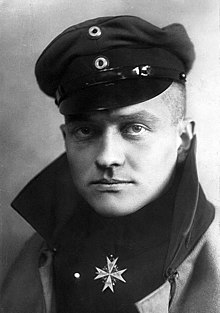The Red Baron
| Manfred von Richthofen | |
|---|---|

Richthofen wears the Pour le Mérite, the "Blue Max", Prussia's highest military order, in this official portrait, c. 1917.
|
|
| Birth name | Manfred Albrecht Freiherr von Richthofen |
| Nickname(s) | Red Baron |
| Born |
2 May 1892 Kleinburg, German Empire (now part of Wrocław, Poland) |
| Died | 21 April 1918 (aged 25) Morlancourt Ridge, near Vaux-sur-Somme, France |
| Allegiance |
|
| Service/branch |
|
| Years of service | 1911–1918 |
| Rank | Rittmeister (Cavalry captain) |
| Unit | |
| Commands held |
|
| Battles/wars | World War I |
| Awards | |
| Relations |
|
| Signature | |
Manfred Albrecht Freiherr von Richthofen (2 May 1892 – 21 April 1918), also widely known as the Red Baron, was a German fighter pilot with the Imperial German Army Air Service (Luftstreitkräfte) during World War I. He is considered the ace-of-aces of the war, being officially credited with 80 air combat victories.
Originally a cavalryman, Richthofen transferred to the Air Service in 1915, becoming one of the first members of Jasta 2 in 1916. He quickly distinguished himself as a fighter pilot, and during 1917 became leader of Jasta 11 and then the larger unit Jagdgeschwader 1, better and popularly known as "The Flying Circus" or "Richthofen's Circus" because of the bright colours of its aircraft, and perhaps also because of the way the unit was transferred from one area of allied air activity to another - moving like a travelling circus in trains, and frequently setting up in tents on improvised airfields. By 1918, Richthofen was regarded as a national hero in Germany, and respected and admired even by his enemies.
Richthofen was shot down and killed near Amiens on 21 April 1918. There has been considerable discussion and debate regarding aspects of his career, especially the circumstances of his death. He remains perhaps the most widely known fighter pilot of all time, and has been the subject of many books, films and other media.
Richthofen was a Freiherr (literally "Free Lord"), a title of nobility often translated as "baron". This is not a given name nor strictly a hereditary title, since all male members of the family were entitled to it, even during the lifetime of their father. Richthofen painted his aircraft red, and this combined with his title led to him being called "The Red Baron" (![]() "der Rote Baron" ), both inside and outside Germany. During his lifetime, he was more frequently described in German as Der Rote Kampfflieger, variously translated as "The Red Battle Flyer" or "The Red Fighter Pilot". This name was used as the title of Richthofen's 1917 autobiography.
"der Rote Baron" ), both inside and outside Germany. During his lifetime, he was more frequently described in German as Der Rote Kampfflieger, variously translated as "The Red Battle Flyer" or "The Red Fighter Pilot". This name was used as the title of Richthofen's 1917 autobiography.
...
Wikipedia
